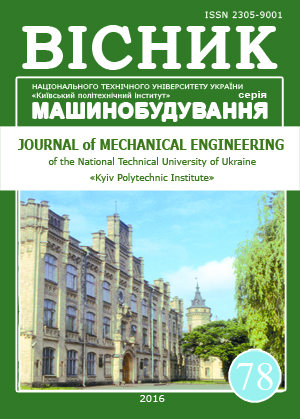NUMERICAL MODELLING OF BOLTED JOINTS FROM COMPOSITE. THE MESSAGE 2. EFFECT OF THE BACKLASH AND PCM STRUCTURE ON THE CHARACTERISTICS OF THE STRESS-STRAIN STATE OF BOLTS
DOI:
https://doi.org/10.20535/2305-9001.2016.78.87475Keywords:
numerical 3D-modelling, composite, a bolt joint, mixed 3D-model composite, FEM.Abstract
In modern finite element class PLM programs have the opportunity to create mixed finite element model by "gluing".
It allows to create, in particular, for calculations on PC rather small 3D-models of polymeric composite materials (PCM) in bolt joints in which composite in zones of bolt-holes is body-sectional modelled, and behind them – approximately, according to the
theory of "the effective module".
Previously it demonstrated the possibility of using a mixed 3D-models of PCM in bolt joints through simulations to determine the minimum size of the zones of more precise PCM simulation while providing the same accuracy of the calculations.
In the given message the substantiation of possibility of application of mixed 3D-models composite is spent at modelling of bolt joints by conducting of numerical experiments for definition of the minimum sizes of zones of more exact modelling composite at
maintenance of equal accuracy of calculations.
The given message is dedicated to the identification of trends in the characteristics of the stress-strained state of bolts when the composite materials structure is changed, to improve the bolt joints strength.
Created 24 of 3D-models of one shear two-row bolt joints with PCM (contact problem), which ranged PCM structure (6 options), as well as the backlash of bolts with holes (4 values).
The value of bolt tightening force and tensile force specimen were unchanged. According to the results of calculations the distribution of minimum stress and contact pressure (tables, graphs) were determined. It is concluded that the structure of a PCM plate significantly affects the characteristics of the stress-strained state of the bolts and of the areas of holes of the PCM; that we can find a structure that will improve the bolt joints strength. It revealed several effects, which can greatly affect the understanding of the characteristics of the stress-strain state of bolt in zones of hole.
References
Dyfuchyn, Y.N. and Rudakov, K.N. (2016), “Numerical Modelling of Bolted Joints From Composite. The Message 1. Creation of the Mixed 3D-Models”, Visn. Nats. tekhn. un-ta Ukrayiny "Kyiv. politekhn. in-t". Seriya mashynobuduvannya, No. 2(77), pp. 100-107.
Rudakov, K. and Dobronravov, A. (2013), “About Influence of Size of a Backlash Between a Bolt and the Hole on the Tension Condition of a Bolt of the Single-Shear Bolted Joint in a "Shearing" Zone”, Visn. Nats. tekhn. un-ta Ukrayiny "Kyiv. politekhn. in-t". Seriya mashynobuduvannya, No. 69, pp. 62–71.
Rudakov, K.N. and Shandura, A.S. (2015), “Numeral Ground of Application of mixed 3D-Modeley Composites at Computations of Bolted Joints”, Visn. Nats. tekhn. un-ta Ukrayiny "Kyiv. politekhn. in-t". Seriya mashynobuduvannya, No. 2(74), pp. 67–76.
Birger, I.A. and Iosilevich, G.B. (1990), Rez'bovye i flantsevye soedineniya [Threaded and flange joints], Mashinostroenie, Moscow, Russia.
Birger, I.A., Shorr, B.F. and Iosilevich, G.B. (1979), Raschet na prochnost' detalei mashin: Spravochnik [Strength calculation of details of machines: the Quick reference], Mashinostroenie,Moscow,Russia.
Strizhius, V.E. (2014), “Calculation method of weariness of shear bolts in metallo-composit connections of elements of aviadesigns”, Nauchnyi vestnik MGTU GA, No. 199(1), pp. 52–61.
Chechulin, B.B., Ushkov, S.S., Razuvaeva, I.N. and others (1977), Titanovye splavy v mashinostroenii [Titanium alloys in machine industry], Mashinostroenie,Leningrad,Russia.
Arzamasov, B.N., Brostrem, V.A., Bushe, N.A. and oth. (1990), Konstrukcionnye materialy: Spravochnik [Constructional materials: Handbook], in B.N. Arzamasova, (ed.), Mashinostroenie,Moscow,Russia.
Pisarenko, G.S., Yakovlev, A.P. and Matveev, V.V. (1988), Spravochnik po soprotivleniyu materialov [The Handbook on Resistance of Materials], in Pisarenko G.S. (ed.), 2 nd, pererab. i dop., Nauk. Dumka, Kiev, Ukraine.
Jonson, K.L. (1985), Contact mechanics.Cambridge:CambridgeUniversityPress.

